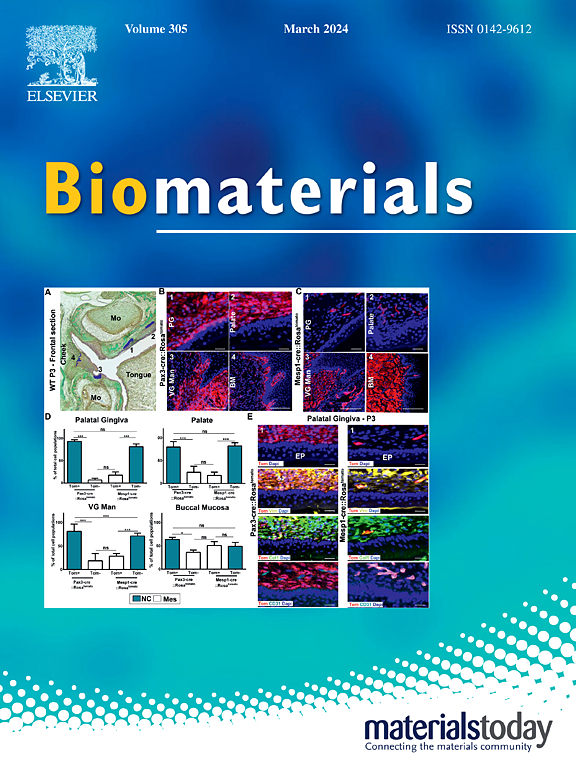增材制造的生物可降解金属的合金化设计和显微结构修饰增强成骨和抗菌
IF 12.8
1区 医学
Q1 ENGINEERING, BIOMEDICAL
引用次数: 0
摘要
增材制造的金属植入物在同时促进成骨和预防感染方面面临着严峻的挑战,这是植入物相关感染等复杂骨科应用中两个相互竞争的要求。本研究提出了一种结合Cu合金和热处理的激光粉末床融合(L-PBF)生物降解锌基种植体的新策略,以解决感染骨的修复问题。合金化后,由于微观结构以固溶体为主,与纯Zn相比,Zn- 2cu钎料的增强效果有限。随后在350℃下热处理3 h, CuZn5析出并加速电偶腐蚀,显著提高了强度和生物降解能力。所得HT/Zn-2Cu合金通过协同强化机制获得了203 MPa的高屈服强度。更重要的是,通过体外和体内的综合测试,在合适的浓度下,Zn2+和Cu2+共同释放具有双重功能。转录组学分析显示,它通过刺激成骨细胞增殖、分化和上调成骨相关基因来增强成骨活性,并通过破坏生物膜和抑制细菌生长来引入有效的抗菌作用。这些发现为设计生物可降解植入物建立了新的范例,同时解决了临床应用中的骨再生和感染预防。本文章由计算机程序翻译,如有差异,请以英文原文为准。
Osteogenic and antibacterial enhancement by alloying design and microstructural modification of additively manufactured biodegradable metals
Additively Manufactured metallic implants face a critical challenge in simultaneously promoting osteogenesis and preventing infection, two competing requirements in complex orthopedic applications such as implant-associated infections. This study presents a novel strategy combining Cu alloying and heat treatment for biodegradable zinc-based implants fabricated by laser powder bed fusion (L-PBF), in order to address infected bone repair. After alloying, the as-built Zn-2Cu implants showed limited enhancement compared to pure Zn due to the microstructure dominated by solid solution. Subsequent heat treatment at 350 °C for 3 h induced CuZn5 precipitation and accelerated galvanic corrosion, remarkably improving strength and biodegradation. The resulting HT/Zn-2Cu alloy achieved a high yield strength of 203 MPa through synergistic strengthening mechanisms. More significantly, the co-released Zn2+ and Cu2+ at favorable concentrations demonstrated dual functionalities according to comprehensive in vitro and in vivo tests. It enhanced osteogenic activity via stimulated osteoblast proliferation, differentiation, and upregulation of osteogenesis-related genes, and introduced potent antibacterial effects through biofilm disruption and bacterial growth inhibition, revealed by transcriptomic analysis. Such findings establish a new paradigm for designing biodegradable implants that concurrently address bone regeneration and infection prevention in clinical applications.
求助全文
通过发布文献求助,成功后即可免费获取论文全文。
去求助
来源期刊

Biomaterials
工程技术-材料科学:生物材料
CiteScore
26.00
自引率
2.90%
发文量
565
审稿时长
46 days
期刊介绍:
Biomaterials is an international journal covering the science and clinical application of biomaterials. A biomaterial is now defined as a substance that has been engineered to take a form which, alone or as part of a complex system, is used to direct, by control of interactions with components of living systems, the course of any therapeutic or diagnostic procedure. It is the aim of the journal to provide a peer-reviewed forum for the publication of original papers and authoritative review and opinion papers dealing with the most important issues facing the use of biomaterials in clinical practice. The scope of the journal covers the wide range of physical, biological and chemical sciences that underpin the design of biomaterials and the clinical disciplines in which they are used. These sciences include polymer synthesis and characterization, drug and gene vector design, the biology of the host response, immunology and toxicology and self assembly at the nanoscale. Clinical applications include the therapies of medical technology and regenerative medicine in all clinical disciplines, and diagnostic systems that reply on innovative contrast and sensing agents. The journal is relevant to areas such as cancer diagnosis and therapy, implantable devices, drug delivery systems, gene vectors, bionanotechnology and tissue engineering.
 求助内容:
求助内容: 应助结果提醒方式:
应助结果提醒方式:


